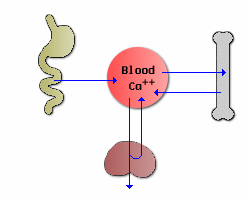2. Calcium belongs to group 2 while Phosphorous belong to group 15.
3. Calcium forms cation while phosphorous forms anion.
- 0
It would be very difficult to name a physiologic process that does not depend, in one way or another, on calcium. It is critical to maintain blood calcium concentrations within a tight normal range. Deviations above or below the normal range frequently lead to serious disease.
Hypocalcemia refers to low blood calcium concentration. Clinical signs of this disorder reflect increased neuromuscular excitability and include muscle spasms, tetany and cardiac dysfunction.
Hypercalcemia indicates a concentration of blood calcium higher than normal. The normal concentration of calcium and phosphate in blood and extracellular fluid is near the saturation point; elevations can lead to diffuse precipitation of calcium phosphate in tissues, leading to widespread organ dysfunction and damage.
Preventing hypercalcemia and hypocalcemia is largely the result of robust endocrine control systems.
Body Distribution of Calcium and PhosphateThere are three major pools of calcium in the body:
- Intracellular calcium: A large majority of calcium within cells is sequestered in mitochondria and endoplasmic reticulum. Intracellular free calcium concentrations fluctuate greatly, from roughly 100 nM to greater than 1 uM, due to release from cellular stores or influx from extracellular fluid. These fluctuations are integral to calcium's role in intracellular signaling, enzyme activation and muscle contractions.
- Calcium in blood and extracellular fluid: Roughly half of the calcium in blood is bound to proteins. The concentration of ionized calcium in this compartment is normally almost invariant at approximately 1 mM, or 10,000 times the basal concentration of free calcium within cells. Also, the concentration of phosphorus in blood is essentially identical to that of calcium.
- Bone calcium: A vast majority of body calcium is in bone. Within bone, 99% of the calcium is tied up in the mineral phase, but the remaining 1% is in a pool that can rapidly exchange with extracellular calcium.
As with calcium, the majority of body phosphate (approximately 85%) is present in the mineral phase of bone. The remainder of body phosphate is present in a variety of inorganic and organic compounds distributed within both intracellular and extracellular compartments. Normal blood concentrations of phosphate are very similar to calcium.
Fluxes of Calcium and PhosphateMaintaining constant concentrations of calcium in blood requires frequent adjustments, which can be described as fluxes of calcium between blood and other body compartments. Three organs participate in supplying calcium to blood and removing it from blood when necessary:
- The small intestine is the site where dietary calcium is absorbed. Importantly, efficient absorption of calcium in the small intestine is dependent on expression of a calcium-binding protein in epithelial cells.
- Bone serves as a vast reservoir of calcium. Stimulating net resorption of bone mineral releases calcium and phosphate into blood, and suppressing this effect allows calcium to be deposited in bone.
- The kidney is critcally important in calcium homeostasis. Under normal blood calcium concentrations, almost all of the calcium that enters glomerular filtrate is reabsorbed from the tubular system back into blood, which preserves blood calcium levels. If tubular reabsorption of calcium decreases, calcium is lost by excretion into urine.
 Hormonal Control Systems
Maintaining normal blood calcium and phosphorus concentrations is managed through the concerted action of three hormones that control fuxes of calcium in and out of blood and extracellular fluid:
Hormonal Control Systems
Maintaining normal blood calcium and phosphorus concentrations is managed through the concerted action of three hormones that control fuxes of calcium in and out of blood and extracellular fluid:- 1

